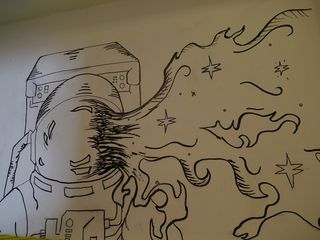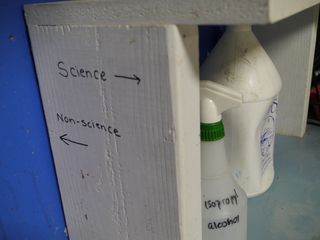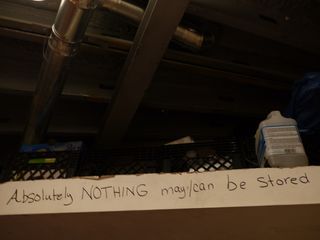Mock Mars Mission: Sending Secret Messages On the Red Planet

Editor's Note: In the Utah desert, scientists attempt to recreate what a real-life mission to Mars might be like. In January, SPACE.com contributor Elizabeth Howell hitched along with Crew 133 for the ride. She sends this look back at hidden messages crew changes on a simulated Red Planet.

The Mars Desert Research Station is a 1,200-square-foot facility in the middle of the Utah desert and is the property of the Mars Society. Crews staying out here, however, are responsible for keeping it clean and safe for simulated missions to the Red Planet.
My crewmembers went over every square inch of this space in our time there. We pulled out the shelves of equipment in the "EVA room" (extra-vehicular activity room) and vacuumed near the walls. We swept out our rooms and wiped down the shelves.
Along the way, we discovered some interesting messages. Most are functional, but there are a few fun surprises for crews to discover.

The first crew for MDRS came here in 2002. The facility has been through a few renovations since that time. For example, some painting a summer or two ago eliminated the tradition of putting crew patches on the doors. ("It looks cleaner," MDRS director Shannon Rupert told SPACE.com in December.)

Certain messages do remain scattered around the MDRS habitat. A large reason for that is institutional memory. Crew handovers are brief, lasting a few hours, and it's possible that somebody could forget that it's not a good idea to store items near the circuit breaker panel, for example.
Other messages are more humorous. On a shelf in the great room downstairs, the word "Science" and an arrow points to the items on the shelf. "Non-Science" points to the wall, where presumably it would be more difficult to do that kind of work.
Get the Space.com Newsletter
Breaking space news, the latest updates on rocket launches, skywatching events and more!
The crew "staterooms" or bedrooms also have murals from people presumably looking for something to do during the two weeks here. The best among them is a flaming astronaut.
Follow Elizabeth Howell @howellspace, or SPACE.com @Spacedotcom. We're also on Facebook and Google+. Original article on Space.com.

Join our Space Forums to keep talking space on the latest missions, night sky and more! And if you have a news tip, correction or comment, let us know at: community@space.com.

Elizabeth Howell (she/her), Ph.D., is a staff writer in the spaceflight channel since 2022 covering diversity, education and gaming as well. She was contributing writer for Space.com for 10 years before joining full-time. Elizabeth's reporting includes multiple exclusives with the White House and Office of the Vice-President of the United States, an exclusive conversation with aspiring space tourist (and NSYNC bassist) Lance Bass, speaking several times with the International Space Station, witnessing five human spaceflight launches on two continents, flying parabolic, working inside a spacesuit, and participating in a simulated Mars mission. Her latest book, "Why Am I Taller?", is co-written with astronaut Dave Williams. Elizabeth holds a Ph.D. and M.Sc. in Space Studies from the University of North Dakota, a Bachelor of Journalism from Canada's Carleton University and a Bachelor of History from Canada's Athabasca University. Elizabeth is also a post-secondary instructor in communications and science at several institutions since 2015; her experience includes developing and teaching an astronomy course at Canada's Algonquin College (with Indigenous content as well) to more than 1,000 students since 2020. Elizabeth first got interested in space after watching the movie Apollo 13 in 1996, and still wants to be an astronaut someday. Mastodon: https://qoto.org/@howellspace
